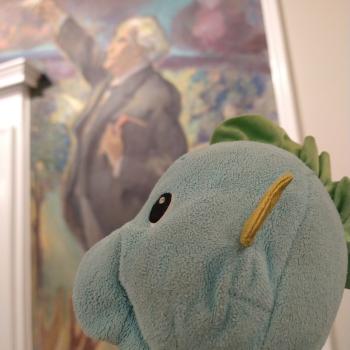Next Tuesday, October 13, faith channels across Patheos are participating in an event called #ShareWhatWeShare, where we’re finding and sharing on our Facebook pages posts from other channels that represent our shared values and commitments. You might think with a tent as big as Patheos we’d find that hard to pull off, but we’re trying it, in the hope that real dialogue between people from differing perspectives will help us see each other as not suspect enemies but (as we say in my home state of Kentucky) “just folks.” That doesn’t mean we play down the differences, but we don’t let them stop the building of relationships.
In that spirit, when the editor at Patheos Pagan wrote a post as a lead-up to #ShareWhatWeShare explaining 10 things people don’t know about modern witchcraft [I have to admit a) that I knew very few of them, and b) that they reiterated for me why I am a Christian and not a pagan!], some of the rest of us thought that “10 things” posts might be a good idea for our channels too! So, if you are a regular reader of this blog, you probably already know this stuff. If not, let this be your introduction.
1) The faith and work movement is not about handing out Bibles on street corners, or leaving tracts in the break room. Bill Peel expressed this very well in his recent participation in a Patheos Head to Head: where workplace faith-sharing exists and succeeds, it exists and succeeds through the development of real relationships.
2) The movement is about helping people see what they do every day, whether it’s changing diapers, pushing buttons, or laying tile, as an expression of God’s creative plan for the world. The movement believes that orthodox Christian doctrine teaches that work is not an expression of the curse laid on humans in the Fall, but is part of God’s original plan for humanity. However….
3) The movement also recognizes that the subjective experience of work does not always express this in easily recognizable ways. As Evan Koons wrote perceptively a few weeks ago, celebrating work theologically is not the same as cheerfully ignoring the real fact that a lot of people’s everyday work actively sucks, for all kinds of reasons: social, cultural, theological, political.
4) The movement is both very new and very old. The modern movement has its origin in some largely evangelical and white-collar trends within late 19th-century and early 20th-century Protestantism, trying to express that Christians in business and secular work should not be seen as “second-class” believers who had missed the ascetic “full-time-Christian-service” bus. But as Bill Droel regularly writes at The Working Catholic, Catholic thinkers from popes to journalists have had a few things to say about this issue too. 🙂
In fact, as you can read every day at the Theology of Work Project blog, concern for how work fits into the human story goes all the way back to the beginning of the Judeo-Christian story as recorded in the Bible. And as Chris Armstrong reminded us in a blog series last year, it’s a question that has troubled and challenged Christian thinkers for 2000 years.
5) The movement is diverse, but it could be more diverse. Our own channel ranges from evangelical to Catholic to mainline bloggers, all committed to a creedal faith and to what C. S. Lewis famously named “mere Christianity.” Our concerns range from workplace ethics (Profession of Faith) to helpful advice (Marketplace Faith) to daily faithfulness in the little things (The High Calling, Visions of Vocation,and (re)integrate) to economics (Oikonomia) to figuring out what the Bible means (TOW Project) to helping connect church and community (Charting Church Leadership) to telling stories of Christian leaders (Centered) and Christian everyday people (Shrinking the Camel and Red Letter Believers). But we (the channel and the movement) could use more female voices, voices of color, and blue-collar voices. We know, and we’re working on it.
6) The movement is all over. As part of keeping all this straight I put our event calendar together and I am regularly surprised at the geographical spread of the movement. Whether you’re in California, New York City, or (like me) “flyover country,” probably somebody somewhere near you is getting a group of Christians together to discuss how to be Christians deeply and with integrity in today’s world.
7) The movement likes to read. A lot. Besides the fact that the Theology of Work Project publishes a whole series of Bible commentaries and runs a website devoted to Biblical commenting, then there’s the fact that we have a whole book review blog (Work Cited. No, I’m not responsible for the bad pun, but the nerd in me does like making a bibliography for a living) and it reviews a lot of books. Some might surprise you!
8) The movement also likes to write (and paint and draw and….). A lot. Not just blog posts, but all sorts of stuff you’d expect from people who see artists as being culture-shapers. We’ve had a faith and work art exhibit, reviewed a faith and work sci-fi novel (really!!!) and we even have the occasional faith and work….poem. (Take it away, Marcus Goodyear.)
9) You can be an earnest faith-at-worker and still have a sense of humor. I give you J. B. Wood and his “Confessions of a Mad Journalist” as exhibit A:
Like most insecure and spiritually frustrated white men in their forties, I keep a journal. Some men hunt. Others play golf. I know one gentleman whose passion is collecting kaleidoscopes. Me, I’ve taken to transcribing the obsessive voices in my head into a handsome series of leather-bound, hand-written manuscripts.
10) Finally, we here at the channel hope that whether you stay to agree or debate, that you’ll stick around and keep reading. Welcome!
Image: Pixabay.













